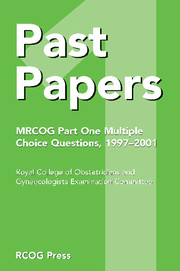Book contents
- Frontmatter
- Contents
- Introduction
- March 1997 – Paper 1
- March 1997 – Paper 2
- September 1997 – Paper 1
- September 1997 – Paper 2
- March 1998 – Paper 1
- March 1998 – Paper 2
- September 1998 – Paper 1
- September 1998 – Paper 2
- March 1999 – Paper 1
- March 1999 – Paper 2
- September 1999 – Paper 1
- September 1999 – Paper 2
- March 2000 – Paper 1
- March 2000 – Paper 2
- September 2000 – Paper 1
- September 2000 – Paper 2
- March 2001 – Paper 1
- March 2001 – Paper 2
- September 2001 – Paper 1
- September 2001 – Paper 2
- Index
September 2001 – Paper 2
Published online by Cambridge University Press: 05 July 2014
- Frontmatter
- Contents
- Introduction
- March 1997 – Paper 1
- March 1997 – Paper 2
- September 1997 – Paper 1
- September 1997 – Paper 2
- March 1998 – Paper 1
- March 1998 – Paper 2
- September 1998 – Paper 1
- September 1998 – Paper 2
- March 1999 – Paper 1
- March 1999 – Paper 2
- September 1999 – Paper 1
- September 1999 – Paper 2
- March 2000 – Paper 1
- March 2000 – Paper 2
- September 2000 – Paper 1
- September 2000 – Paper 2
- March 2001 – Paper 1
- March 2001 – Paper 2
- September 2001 – Paper 1
- September 2001 – Paper 2
- Index
Summary
1. Ketone bodies
A. can be utilised by the fetal brain.
B. include aceto-acetate.
C. are water soluble.
D. are synthesised in skeletal muscle.
E. can be utilised during starvation.
2. Intracellular fluid differs from extracellular fluid in that
A. it forms the larger proportion of total body water.
B. its volume can be more readily measured.
C. it has a higher concentration of potassium.
D. its volume is more directly regulated by the kidneys.
E. it has a lower concentration of sodium.
3. The oxidation of pyruvate to carbon dioxide
A. occurs exclusively in mitochondria.
B. can occur under anaerobic conditions.
C. involves intermediates that are also involved in amino acid catabolism.
D. is regulated by the concentration of acetyl coenzyme A in the cell.
E. is impaired in thiamine deficiency states.
4. Creatinine
A. is filtered out by the glomerulus.
B. is reabsorbed significantly by the proximal tubules.
C. plasma concentration increases after protein ingestion.
D. has a plasma clearance rate equivalent to renal plasma flow.
E. plasma concentration increases during the first trimester of pregnancy.
5. ABO antigens are
A. glycoproteins.
B. found only on erythrocytes.
C. major histocompatibility antigens.
D. not immunogenic during pregnancy.
E. located on membranes.
6. Haemoglobin
A. has four porphyrin rings.
B. can carry four molecules of oxygen.
C. binds carbon monoxide more readily than oxygen.
D. is synthesised in mature erythrocytes.
E. contains two beta chains.
- Type
- Chapter
- Information
- Past Papers MRCOG Part One Multiple Choice Questions1997–2001, pp. 192 - 201Publisher: Cambridge University PressPrint publication year: 2004



